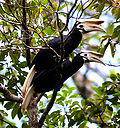| Anthracoceros | |
|---|---|
 | |
| Oriental pied hornbill (Anthracoceros albirostris) | |
| Scientific classification | |
| Kingdom: | Animalia |
| Phylum: | Chordata |
| Class: | Aves |
| Order: | Bucerotiformes |
| Family: | Bucerotidae |
| Genus: | Anthracoceros Reichenbach, 1849 |
| Type species | |
| Buceros monoceros [1] Shaw, 1811 | |
| Species | |
Anthracoceros coronatus | |
Anthracoceros is a genus of birds in the family Bucerotidae.
The genus was introduced by the German naturalist Ludwig Reichenbach in 1849. [2] The type species was subsequently designated as the Malabar pied hornbill (Anthracoceros coronatus). [3] [4] The genus name comes from Ancient Greek ἄνθραξ (ánthrax), meaning "coal", and κέρας (kéras), meaning "horn". [5] A molecular phylogenetic study published in 2013 found that Anthracoceros was sister to the genus Ocyceros which contains the three grey hornbill species. [6]
The genus contains five species: [7]
| Image | Scientific name | Common name | Distribution |
|---|---|---|---|
 | Anthracoceros coronatus | Malabar pied hornbill | India and Sri Lanka |
 | Anthracoceros albirostris | Oriental pied hornbill | Bangladesh, Bhutan, Brunei, Cambodia, China (Guangxi, Yunnan and Tibet), Eastern and Northern India, Indonesia, Laos, Malaysia, Myanmar, Nepal, Singapore, Thailand and Vietnam |
 | Anthracoceros malayanus | Black hornbill | Asia in Brunei Darussalam, Indonesia, Malaysia, Singapore, Thailand. |
 | Anthracoceros marchei | Palawan hornbill | Greater Palawan, Philippines |
| Anthracoceros montani | Sulu hornbill | Greater Sulu, Philippines | |







